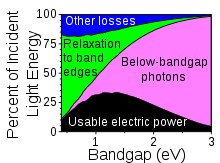Multiple exciton generation

In solar cell research, carrier multiplication is the phenomenon wherein the absorption of a single photon leads to the excitation of multiple electrons from the valence band to conduction band. In the theory of a conventional solar cell, each photon is only able to excite one electron across the band gap of the semiconductor, and any excess energy in that photon is dissipated as heat. In a material with carrier multiplication, high-energy photons excite on average more than one electron across the band gap, and so in principle the solar cell can produce more useful work.
In quantum dot solar cells, the excited electron in the conduction band interacts with the hole it leaves behind in the valence band, and this composite uncharged object is known as an exciton. The carrier multiplication effect in a dot can be understood as creating multiple excitons, and is called multiple exciton generation (MEG). MEG may considerably increase the energy conversion efficiency of nanocrystal based solar cells, though extracting the energy may be difficult because of the short lifetimes of the multiexcitons.
The quantum mechanical origin of MEG is still under debate and several possibilities have been suggested:[1]
- 1) Impact ionization: light excites a high-energy exciton (X) which decays irreversibly into a quasi-continuum of multiexciton (multi-X) states available at this energy. The model requires only the density of states of multiexcitons being very high, while the Coulomb coupling between X and multi-X can be quite small.
- 2) Coherent superposition of single and multiexciton states: the very first suggested model but oversimplified (high density of states of multi-X is not taken into account). Light excites an X (which is not a true eigenstate of the system) which can then coherently covert to multi-X and back to X many times (quantum beats). This process requires Coulomb coupling between them to be much stronger than the decay rate via phonons (which is usually not the case). The excitation will finally decay via phonons to a lower energy X or multi-X, depending on which of the decays is faster.
- 3) Multiexciton formation through a virtual exciton state. Light directly excites the eigenstate of the system (in this case, a coherent mixture of X and multi-X). The term "virtual" relates here to a pure X, because it is not a true eigenstate of the system (same for model 2).
All of the above models can be described by the same mathematical model (density matrix) which can behave differently depending on the set of initial parameters (coupling strength between the X and multi-X, density of states, decay rates).
MEG was first demonstrated in 2004 using colloidal PbSe quantum dots[2] and later was observed for quantum dots of other compositions including PbS, PbTe, CdS, CdSe, InAs, Si,[3] and InP.[4] Multiple exciton generation was also detected in semiconducting single-walled carbon nanotubes (SWNTs) upon absorption of single photons. [5] For (6,5) SWNTs, absorption of single photons with energies corresponding to three times the SWNT energy gap results in an exciton generation efficiency of 130% per photon. The multiple exciton generation threshold in SWNTs can be close to the limit defined by energy conservation.
Graphene, which is closely related to nanotubes, is another material in which multiple exciton generation has been observed.[6]
Double-exciton generation has additionally been observed in organic pentacene derivatives through singlet exciton fission with extremely high quantum efficiency.[7]
References
- ↑ Space-separated quantum cutting with silicon nanocrystals for photovoltaic applications. Nature Photonics 2, 105 (2008)
- ↑ Schaller, R.; Klimov, V. (2004). "High Efficiency Carrier Multiplication in PbSe Nanocrystals: Implications for Solar Energy Conversion". Physical Review Letters. 92 (18): 186601. arXiv:cond-mat/0404368
 . Bibcode:2004PhRvL..92r6601S. doi:10.1103/PhysRevLett.92.186601. PMID 15169518.
. Bibcode:2004PhRvL..92r6601S. doi:10.1103/PhysRevLett.92.186601. PMID 15169518. - ↑ "MEG in colloidal silicon nanocrystals" (PDF). Nano Letters. 7: 2506. 2007. doi:10.1021/nl071486l.
- ↑ "Efficient carrier multiplication in InP nanoparticles". 16 February 2010.
- ↑ "Multiple exciton generation in single-walled carbon nanotubes". 14 July 2010. doi:10.1021/nl100343j.
- ↑ Tielrooij, K.J.; Song, J C.W.; Jensen, S.A.; Centeno, A.; Pesquera, A.; Zurutuza Elorza, A.; Bonn, M.; Levitov, L.F.; Koppens, F.H.L. (24 February 2013). "Photoexcitation cascade and multiple hot-carrier generation in graphene". Nature Physics. 9: 248–252. doi:10.1038/nphys2564. Retrieved 17 March 2015.
- ↑ D. N. Congreve, "External Quantum Efficiency Above 100% in a Singlet-Exciton-Fission–Based Organic Photovoltaic Cell", Science, 2013 vol. 340 (6130) pp. 334-337